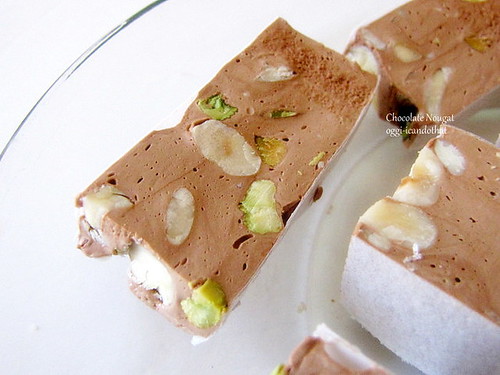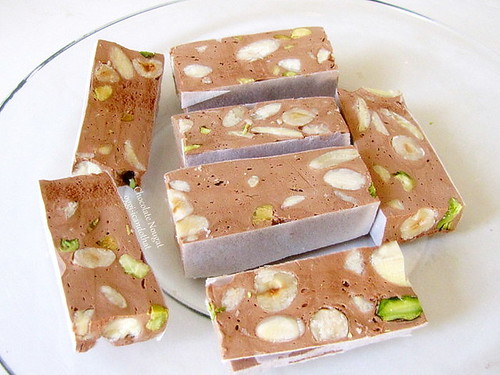This is the third time I made this kind of suman and unlike the previous two [inedible] suman sa moron, this recipe I adapted from here is the best and most probably the most authentic. I'm not from the Visayas region where this type of suman comes from and didn't have them back in the Philippines either. But I can honestly say this recipe makes the most delicious and very soft suman with a strong smoky chocolate flavor (from Antonio Pueo tablea) and this suman is now on our list of all-time favorite Filipino treats. I can't stop eating them; they're great as a snack and for breakfast with barako coffee or hot ginger tea.
Suman sa morón is a cigar-shaped two-toned rice cake made with both glutinous and regular rice flours cooked in coconut milk, sugar, chocolate, and peanuts, wrapped in banana leaves and steamed for an hour. The recipe has julienned cheddar cheese added to the chocolate portion but I omitted it. I don't know the exact amount of chocolate to substitute for the tablea if you can't find them in your area. You can start with 8 ounces of semi-sweet or dark chocolate and just eyeball the color and texture, taste the cooked paste, and adjust to your preference.
Suman sa Morón
½ cup glutinous rice flour
1½ cups regular rice flour
4 ounces whole milk
½ cup sugar
½ cup fine muscovado (raw) sugar, or more to taste
8 chocolate tablea, softened with 2 tablespoons hot water
¼ cup chopped roasted peanuts
1 teaspoon vanilla extract
2 cups coconut milk, divided
julienned cheddar cheese, optional
banana leaves, cut into 8 x 10-inch pieces
about 4 dozens 5-inch long kitchen strings
- With a wire whisk, thoroughly mix the 2 types of flour and divide equally into two parts.
- In a non-stick wok, place one part of the rice mixture, add the sugar, whole milk, and 1 cup coconut milk. Stir until blended and cook, constantly stirring, on medium heat until thick. It will be lumpy but will become smooth as it thickens. Transfer into a plate and let cool.
- In the same wok, place the rest of the flour mixture and add the remaining one cup coconut milk, muscovado sugar, chocolate, vanilla extract, and peanuts. Mix well and cook over medium heat while constantly stirring. Turn off the heat when mixture starts becoming oily and is smooth. Transfer into a plate and set aside to cool.
- Pass the banana leaves over stove flame to make them supple.
- Take a heaping tablespoonful of the chocolate mixture and place on the banana leaf wrapper. Sprinkle a little cheese, if using, before rolling with the banana leaf covering the mixture and roll into a ¾ inch thick rope. Take a heaping tablespoonful of the plain milk mixture and do the same process. Place the two ropes side by side and roll to form a thicker rope with the two colors fused together.
- Roll the banana leaf to wrap tightly and tie a string at both ends to secure.
- Repeat the process until all of the two mixtures have been rolled and wrapped.
- Steam in rapidly boiling water for 1 hour.
best eaten when hot with a cup or two of strong barako coffee
Kulinarya was started by a group of Filipino foodies living in Sydney, who are passionate about the Filipino culture and its colourful cuisine. Each month we will showcase a new dish along with their family recipes. By sharing these recipes, we hope you find the same passion and love for Filipino Food as we do.
Suman, October's theme, is hosted by Sheryl http://crispywaffle.com/ and Divina http://www.sense-serendipity.com/


